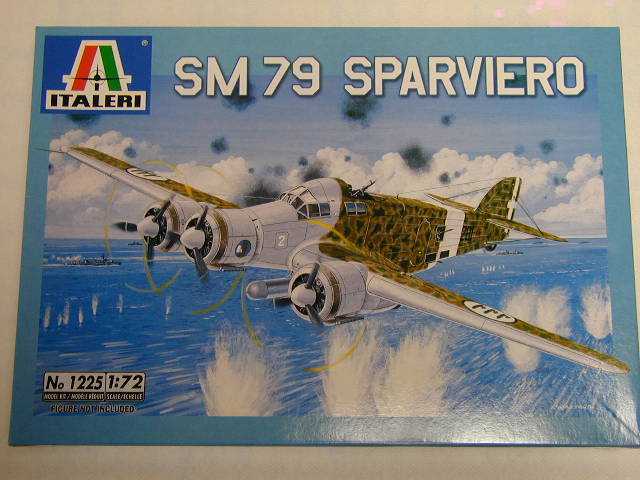|
Savoia-Marchetti S.79

Italeri 1/72
S
u m m a r y
|
| Catalogue Number: |
1225 |
| Scale: |
1/72 |
| Contents and Media: |
106 styrene parts (incl.14 clear
parts) |
| Price: |
Unknown at this stage |
| Review Type: |
FirstLook |
| Advantages: |
Brand new
moulding; fine recessed panel lines; characteristic ribbed effect in
place; separate control surfaces; boxed-in wheel wells; generally accurate |
| Disadvantages: |
Some minor discrepancies with
reference drawings |
| Recommendation: |
Recommended |
Reviewed by Scotty Battistoni

Italeri's 1/72 scale Savoia-Marchetti S.79 is
available online from
Squadron.com
The Savoia Marchetti S. 79
Sparviero was first developed for the Italian Aeronautical Industry in the
mid 1930’s. The first use of the S. 79 was for the postal service and
racing. Then in the late 1930’s the first bomber version of the S. 79
appeared. The S. 79 would prove to be a faithful bomber to the Regia
Aeronautica throughout WWII. Savoia Marchetti tried a follow on design
called the SM. 84, but the aircraft was unsuccessful compared to the
beloved S.79. The S. 79 was also used as a Torpedo platform for the Regia
Aeronautica as well.
Now on with the kit review. It has been a great past couple of years for
us Italian aficionados. With companies such as Classic Airframes, Pacific
Coast Models, Aviation Usk, and now Italeri, the gaps in WWII Italian
aircraft are slowly being filled in. First off, I want to say a big “Thank
You” to Italeri / The Testor Corporation for getting me this kit as quickly
as they did for review.
The Italeri S. 79 has been long in
the waiting. Let me say that this is NOT a rehash of the Airfix kit. The
Italeri kit is a completely new tool and has no commonality with the
ancient Airfix kit. The kit of comprised of approximately 106 styrene
parts (14 of these are clear parts).
Click the images below to view larger images:
The airframe components feature
fine recessed panel lines. Also present is the “Ribbed fabric effect” on
the fuselage, horizontal and vertical tail surfaces. While some modelers
may feel this is a bit overdone, I myself do not agree. Many photos reveal
that the S. 79’s have a very pronounced “ribbed effect” on the fuselage.
Also, model building is an art, and as an artist, I prefer a little more
pronounced fabric ribbed effect.
The cockpit comprises about
15 pieces along with molded on fuselage sidewall detail. As is the kit
cockpit will look fine once the fuselage is all buckled up as you can’t
really see much in there anyway. This is one area that modelers need to
realize that Italeri had to compromise on tooling costs. The real interior
of a SM. 79 is a nightmare. A good analogy would be a “Jungle Gym” inside
of a fuselage.
All control surfaces are separate
and you get boxed in wheel wells. The torpedo is well executed, as is the
nifty and well done crew access door on the side of the fuselage.
I compared the kit to the drawings
in the Ali D Italia books on the SM. 79. Everything lines up perfectly
except for the following areas. The rudder hinge line is too far aft by
about .030 of an inch. The trailing edges of the wing root fillet need to
be slightly larger. However, that being said the kit definitely looks like
a SM. 79 and it is a quantum leap over the ancient Airfix relic.
Overall, I am very satisfied with
this new Italeri offering of a much-needed model. “For you guys at Italeri,
Job well done and Thank You for releasing this kit”
Now if we could only convince
Italeri for a new Cant. 1007 Alcione in 1/72, hint, hint...
Recommended
Model, Review and Images Copyright © 2003 by Scott Battistoni
Page Created 11 November, 2003
Last updated 15 May, 2006
Back to HyperScale Main Page
Back to Reviews Page
|
Home | What's
New | Features
| Gallery |
Reviews | Reference
| Forum
| Search